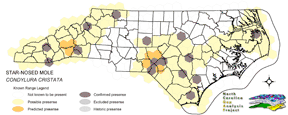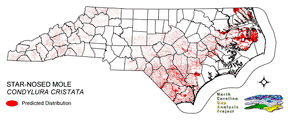
| Taxa: |
| Order: |
| Family: |
| Mammalia |
| Insectivora |
| Talpidae |
| NatureServe Global Rank: |
| NatureServe State (NC) Rank: |
| G5 |
| S4 |
| Federal Status: |
| NC State Status: |
| --- |
| --- |


| Land Unit |
| US Fish & Wildlife Service |
| US Forest Service |
| US National Park Service |
| US Department of Defense |
| NC State Parks |
| NC University System |
| NC Wildlife Res. Com. |
| NC Forest Service |
| NC Div. of Coastal Mgmt. |
| Local Governments |
| Non-Governmental Org. |
| Other Public Lands |
| Private Lands |
| GAP Status 1-2 |
| All Protected Lands |
| Statewide |
| Hectares |
| 98,804.70 |
| 6,214.50 |
| 23,859.09 |
| 1,482.57 |
| 11,645.82 |
| 3,219.39 |
| 41,383.35 |
| 7,247.79 |
| 7,103.70 |
| 547.47 |
| 19,332.72 |
| 455.85 |
| 970,425.00 |
| 169,776.00 |
| 220,810.95 |
| 1,191,721.95 |
| Acres |
| 244,151.68 |
| 15,356.36 |
| 58,957.08 |
| 3,663.51 |
| 28,777.44 |
| 7,955.28 |
| 102,260.46 |
| 18,132.07 |
| 17,553.62 |
| 1,352.83 |
| 47,772.18 |
| 1,126.43 |
| 2,397,971.93 |
| 419,747.95 |
| 545,858.03 |
| 2,945,030.89 |
| % of Dist. on |
| Prot. Lands |
| 44.7 % |
| 2.8 % |
| 10.8 % |
| 0.7 % |
| 5.3 % |
| 1.5 % |
| 18.6 % |
| 3.3 % |
| 3.2 % |
| 8.7 % |
| 8.7 % |
| < 0.1 % |
| 0.1 % |
| 76.9 % |
| ----- |
| ----- |
| % of Dist. on |
| All Lands |
| 8.3 % |
| 0.5 % |
| 2.0 % |
| 0.1 % |
| 1.0 % |
| 0.3 % |
| 3.5 % |
| 0.6 % |
| 0.6 % |
| < 0.1 % |
| 1.6 % |
| < 0.1 % |
| 81.4 % |
| 14.2 % |
| ----- |
| ----- |
|
This mole is locally common in the southern and mid-Appalachian mountains, and uncommon to rare in the Coastal Plain of southern Virginia and the Carolinas (Webster et al. 1985). Typically found where mesic to hydric soil conditions of lowland meadows, fields and woodlands which abut swamps and slow flowing streams (Whitaker and Hamilton 1998). Less common in upland forests where dense vegetative cover produces damp ground litter and soils, or in upland grasslands where rains produce temporary and seasonal pools and/or wet sites. NATURE SERVE GLOBAL HABITAT COMMENTS: Seldom far from bodies of water. Prefers wet soils in flood plains, swamps, meadows, and other openings near water. Good swimmer and diver. May be active in water under ice in winter. More dependent on water in winter when ground is frozen. Occasionally occurs in leaf mold on the floor of dense forests. Tunnels may be shallow or deep and may open at ground surface or under water. Nest usually is placed in a hummock, under a stump or log, in humus among rotten tree roots, or in other areas above high water, often near a stream. NATURE SERVE STATE HABITAT COMMENTS: Closely associated with wetland habitats in N.C. as well. In the mountains, these wetlands may be small seepage areas in upland habitats, marshes, or riparian areas. We know less about the habitats used by this species in the coastal plain of N.C. |
| Code | Name | Description | NC Natural Heritage Program Equivalent |
| 75 | Tidal Swamp Forest | Swamp tupelo dominated forest with or without black tupelo and/or cypress trees. Restricted to the tidal zones in the coastal plain. May have inclusions of coastal red cedar woodlands. | Tidal cypress - gum swamp |
| 380 | Coastal Plain Fresh Water Emergent | Emergent vegetation in fresh water seepage bogs, ponds and riverbeds of the coastal plain. Includes alliances dominated by sedges, eelgrass, as well as cane found in unforested cane-brakes. | Small Depression Pond, Sandhill Seep, Floodplain Pool, Unforested Floodplain Canebrake, Riverscour Prairies, Vernal Pools |
| 173 | Coastal Plain Riverbank Shrubs | Shrub dominated riverbanks, commonly dominated by willows and/or alders. | Sand and Mud Bar |
| 50 | Coastal Plain Mixed Bottomland Forests | Includes forests dominated by a variety of hardwood species, including sweetgum, cottonwood, red maple. | Coastal Plain Bottomland Hardwood (in part), Coastal Plain Levee Forest |
| 49 | Coastal Plain Oak Bottomland Forest | Bottomland forests dominated by deciduous oak alliances. Oaks represented can include swamp chestnut, cherrybark, willow, and/or overcup oak. Inclusions of loblolly pine temporarily flooded forests occur in patches. Hydrology is temporarily to seasonally flooded. | Coastal Plain Bottomland Hardwoods (in part) blackwater subtype, brownwater subtype |
| 158 | Coastal Plain Nonriverine Wet Flat Forests | Loblolly pine - Atlantic white-cedar - red maple - swamp tupelo saturated forests as well as forests dominated by loblolly, sweetgum, and red maple in non-riverine flats. | Non-riverine Wet Hardwood Forest |
| 41 | Peatland Atlantic White-Cedar Forest | Dense stands of Atlantic white cedar with saturated hydrology. Can include swamp tupelo, red maple, and pond pines with a moderate shrub and herb layer. | Peatland Atlantic White-Cedar Forest |
| 15 | Seepage and Streamhead Swamps | Includes extensive peat flats in the coastal plain, dominated by swamp tupelo, maples, and Atlantic white cedar alliances. In the sandhills includes streamhead pond pine and bay forests alliances. Saturated hydrology. | Bay Forest, Small Depression Pocosin, Streamhead Atlantic White Cedar Forest, Streamhead Pocosins |
| 30 | Cypress-Gum Floodplain Forests | Swamps dominated by black or swamp tupelo with or without Taxodium. Seasonally to semi-permanently flooded hydrology. | Cypress-Gum Swamps |
| 78 | Pond-Cypress - Gum Swamps, Savannas and Lakeshores | Cypress dominated swamps and lakeshores. Can include bays dominated by pond cypress or shorelines of coastal plain lakes with a narrow band of cypress. | Non-riverine Swamp Forest, Natural Lakeshores (in part) |
| 385 | Oak Bottomland Forest and Swamp Forest | The swamp chestnut oak, cherrybark oak, shumard oak and sweetgum alliance is one representative. Other alliances are dominated by water, willow, and overcup oaks. Swamp forests can be dominated by sweetgum, red maple, and black gum being dominant. Loblolly can occur in combination with sweetgum and red maple, or with tulip poplar. Includes saturated and semi- to permanently flooded forests in the mountains. | Piedmont/Mountain Bottomland Forest, Piedmont/Mountain Swamp Forest |
| 87 | Pocosin Woodlands and Shrublands | Includes pond pine woodland, low pocosin and high pocosin shrub dominated areas. Canebrakes and bay forests may be present. | Pond Pine Woodlands, Peatland Canebrake, Small Depression Pocosin |
| 67 | Wet Longleaf or Slash Pine Savanna | Wet flatwoods and pine savannas, typically dominated by longleaf pines, but slash or pond pines may be the dominant pines. | Wet Pine Flatwoods |
| 238 | Piedmont/Mountain Submerged Aquatic Vegetation | Seasonally to permanently flooded areas with aquatic vegetation. Waterlily, pondweed, hydrilla smartweed are a few of the species that can occur. | Piedmont/Mountain Semipermanent Impoundment (in part) |
| 239 | Piedmont/Mountain Emergent Vegetation | Emergent vegetation of all wetland hydrologies. Sites would commonly support species such as tussock sedge, rushs, and cattail alliances. | Rocky Bar and Shore (in part) |
| 267 | Riverbank Shrublands | Riverside shrubs with temporarily flooded hydrologies. Found in the both the Mountains and Piedmont. Containing dominants such as smooth alder and a Carolina or black willows. | Sand and Mud Bar |
| 269 | Floodplain Wet Shrublands | Saturated shrublands of the Piedmont, includes buttonbush, swamp-loosestrife, decodon and alders. | Piedmont/mountain Semipermanent Impoundment |
| 384 | Piedmont/Mountain Mixed Bottomland Hardwood Forests | Includes temporarily to seasonally forests dominated by hardwood species. Hardwoods include sweetgum, red maple, sycamore which co-occur in a mosaic of bottomland and levee positions. Includes alluvial hardwood forests in the mountains. Hemlock and white pine may occur as inclusions, but are generally mapped separately. | Piedmont/Mountain Alluvial Forest, Piedmont/Mountain Levee Forest |
| 205 | Agricultural Pasture/Hay and Natural Herbaceous | Farm fields used for pasture grass or hay production, as well as old fields dominated by native and exotic grasses. | No equivalent |
| 202 | Residential Urban | Includes vegetation interspersed in residential areas. Includes lawns, mixed species woodlots, and horticultural shrubs. Vegetation accounts for between 20 - 70% of the cover. | No equivalent |
| 8 | Open water | Open water without aquatic vegetation. | No equivalent |
| 527 | Appalachian Hemlock | Upland hemlock forests of the moutains region. Vary from side slopes to steep slope positions. | Canada Hemlock Forest |
| 533 | Appalachian Swamp Forest | Evergreen and deciduous forests with saturated hydrologies. This class may contain a variety of trees species, including hemlock - red maple, pitch pine, and white pine forests. | Swamp Forest-Bog Complex, Southern Appalachian Bog, Southern Appalachian Fen |
| 534 | Appalachian Wet Shrubland/ Herbaceous | Saturated shrubs and herbaceous vegetation. Often mapped as an inclusion in Appalachian Swamp Forest. | Southern Appalachian Bog, Southern Appalachian Fen |
|
Hamilton, W.J. 1931. Habits of the star-nosed mole (Condylura cristata) Jour. Mamm. 12(4):345-355.
Jackson, H. H. T. 1915. A review of the American moles. North American Fauna 38:1-100. Nowak, R. M. 1991. Walker's mammals of the world. Fifth edition. Vols. I and II. Johns Hopkins Univ. Press, Baltimore. 1629 pp. Jones, J. K., Jr., et al. 1992. Revised checklist of North American mammals north of Mexico, 1991. Occas. Pap. Mus., Texas Tech Univ. (146):1-23. Wilson, D. E., and D. M. Reeder (editors). 1993. Mammal Species of the World:a Taxonomic and Geographic Reference. Second Edition. Smithsonian Institution Press, Washington, DC. xviii + 1206 pp. Whitaker, J.O. Jr. and W.J. Hamilton, Jr. 1998. Mammals of the eastern United States. Cornell Univ. Press, Ithaca, New York. 583 pp. Banfield, A.W.F. 1974. The mammals of Canada. University of Toronto Press, Toronto. Peterson, K. E., and T. L. Yates. 1980. CONDYLURA CRISTATA. Am. Soc. Mamm., Mammalian Species No. 129:1-4. Baker, Rollin H. 1983. Michigan mammals. Michigan State University Press. 642 pp. van Zyll de Jong, C. G. 1983. Handbook of Canadian Mammals. 1. Marsupials and insectivores. Nat. Mus. Canada, Ottawa. 212 pp. Webster, W. D., J. F. Parnell and W. C. Biggs Jr. 1985. Mammals of the Carolinas, Virginia, and Maryland. The University of North Carolina Press, Chapel Hill, NC. Gorman, M. L., and R. D. Stone. 1990. The natural history of moles. Cornell Univ. Press. 208 pp. |
For more information please contact them at:
NC-GAP Analysis Project
Dept. of Zoology, NCSU
Campus Box 7617
Raleigh, NC 27695-7617
(919) 513-2853
www.basic.ncsu.edu/ncgap